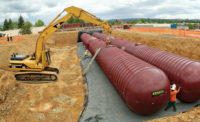Renovating a historic building in the heart of a major metropolis always will cause some heartburn for the principals.
The Wilshire Grand Center and the city of Los Angeles was no exception for Brian Callahan, president of Santa Ana, California-based design-build firm XL Fire Protection.
Callahan, in partnership with Xylem Bell & Gossett were A-C Fire Pump, worked for three years to provide the 2.1-million-square-foot Wilshire Grand Center with an enhanced, sustainable fire-protection system during the hotel’s expansive $20 million makeover. Today, the 73-story glass-and-steel Wilshire Grand Center is valued at $1.35 billion and is the tallest building in the United States west of Chicago’s Willis Tower.
The Wilshire Grand Center — originally known as the Hotel Statler when it opened in 1952 — selected Callahan and XL Fire Protection because of the strong working relationship Callahan’s company has with Starfire, an Anaheim, California-based Xylem A-C Fire Pump distributor.
“Starfire worked with us to meet the requirements of the job,” Callahan states. He adds that XL was responsible for the design, calculations, testing and installation of all the Wilshire’s sprinkler systems.
Starfire’s Paul Bennett says the Wilshire Grand Center was no ordinary job for all parties involved in the design and installation.
“Because of the staging of the pumps, it took a lot of fine-tuning of the product to meet the customer’s requirements,” he says. “It was an involved process, much more than typical jobs. High-rise projects in Los Angeles are far more demanding than a warehouse project. We have to spend a lot more time to make sure the pumps properly perform.”
Los Angeles and the state of California have strict fire-safety building codes. The facility’s design was driven by NFPA 20: Standard for the Installation of Stationary Pumps for Fire Protection, according to Brian Buscher, global product manager — fire protection with Xylem.
“Because of the requirements of the city of Los Angeles for maximum pressure, we had a lot of back and forth on pump selection,” Buscher notes.
Buscher states city officials would immediately fail the facility’s acceptance test if one gauge read even one hair more than 600 psi as the pumps are churning.
“This is a hard ceiling,” he says.
Callahan, Buscher and their respective teams designed a system featuring two pumps working in series. “(Therefore), both pumps need to be spot-on the factory curve when operating in the field,” Buscher says.
He adds: “This is a tall building, so that factor alone got us close to the 300-psi limit per pump. Because it was so close, we had to hit the design point. NFPA 20 requires shutoff head to not exceed 140% of the design pressure and can’t be below 65% at 150% of the rated flow.”
In the details
Callahan says he sketched out the Wilshire Grand Center design on a napkin and impressed decision-makers with the ability to create a system that required only one fire-pump room.
“By getting the number of pumps down to six there was no need for an additional emergency generator, saving project cost,” he explains.
After the design was ready to go the team had to make sure it would work as planned. There is a high zone with vertical turbine pumps and a low zone with A-C Fire Pump 8200 series horizontal split-case pumps that are specified in the building. It required plenty of sizing and theoretical planning on the pump curves, especially in the high zone. Los Angeles code requirements demanded an exact set of redundant fire pumps on each level, meaning six total pumps were installed.
“We had to run a lot of calculations to predict that we could meet the requirement,” Buscher says. “Then there was a lot of coordination between our Morton Grove, Illinois, plant where we make the split case pumps and the Lubbock, Texas, plant where we make our turbine pumps. We had to be sure that together we actually delivered the combined performance.”
The vertical pump and the horizontal split pump were a perfect tag team for the Wilshire Grand Center. “The vertical was a bit over psi, but the horizontal was under psi,” Buscher states. “So we met the requirements.”
Bennett adds: “One pump services the low zone, but the high-zone portion requires two pumps in series to create the 600 psi that was required.”
The only specific modification made was to adjust the standard impeller trim diameter, Buscher says.
“(We made the change) so it was not overpressurizing the system components downstream of the pump,” he notes. “We retained that information in our records in case the customer ever needs a new impeller.”
Additionally, Callahan used pressure-reducing valves to control the pressure throughout the fire-sprinkler system.
“We were able to control the static pressure the turbine pumps generated,” he says. “Even at churn, the pumps were generating 77 psi, so we needed a pressure-reducing valve on the standpipe.”
The innerworkings
The original Wilshire Grand’s HVAC system accounted for as much as 50% of the building’s commercial building energy use, thus designing a new, efficient heating and cooling system was important to meeting the LEED Gold sustainability goal.
The system specified Bell & Gossett pumps featuring a central plant with high-efficiency chillers and condensing boilers to supply chilled and hot water throughout the facility. Los Angeles-based ACCO Engineered Systems designed the HVAC system and John Boncich, the firm’s senior vice president, noted they had to design obstacles to overcome.
“A major challenge on the project was the construction had to begin prior to the completion of the design,” he says.
The Wilshire Grand Center stands 1,100 feet high, anchored by a seven-level podium structure featuring retail, restaurants, meeting rooms, ballrooms and a swimming pool. On top of the podium is 400,000 square feet dedicated to office space.
The podium and office levels are supplied chilled and hot water by Bell & Gossett 300-psig working pressure VSX and e-1510 pumps. The thermal energy storage system is served standard working pressure VSX pumps on the podium’s second level. That thermal energy storage system charges a large water tank overnight to lower the number of chillers needed to operate the building throughout the day.
Other elements of the Wilshire Grand’s HVAC system include Bell & Gossett AHRI-400 certified plate-and-frame heat exchangers that isolate the facility’s pressure zones from each other. Also, the HVAC system includes air separators and expansion tanks that adjust pressures in the hydronic system in response to building temperature changes.
More VSX pumps are used to provide comfort to guests at the Intercontinental Los Angeles Downtown hotel, which covers floors 31-66, has nearly 900 rooms, a sky lobby on the 70th floor, and bars and restaurants on floors 69 and 71. Bell & Gossett e-90 inline pumps provide radiant floor heating and cooling in the ground-floor lobby and in the sky lobbies.
Pomona, California-based manufacturers representative Dawson Co. supplied the HVAC system and vice president of commercial sales Manuel Masso notes how the units provided benefits beyond energy efficiency.
“Besides the versatility and robustness the VSX brings to a high-efficiency hydronic system, it’s easily serviceable and its compact design takes up less space in the pump room,” he says. “De-creasing the size of mechanical rooms means more saleable space.”
Cohesive unit
Despite all the elements of the Wilshire Grand Complex it covers only 2.8 acres and it did not offer extra space to store materials during or after construction. Products were lifted by cranes when needed.
During testing, the fire-protection team adjusted sequencing with the pump controller and was able to close the startup gap from 10-15 seconds to seven.
“In the end, everything worked as designed,” Callahan declares. “It’s not just putting in products; everything had to properly perform as a system and meet code.”
The new beacon of the Los Angeles skyline stands out for reasons beyond height and, according to Bennett, it was because of a coordinated team effort.
“Customer service is so important in our industry, especially on high-profile projects such as the Wilshire Grand Center,” he says. “Having those personal relationships with customers such as XL Fire Protection means they know we will do what needs to be done to meet the requirements of the job.”
This article was originally titled “Fire protection grand slam” in the May 2018 print edition of PM Engineer.




